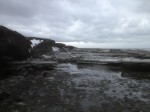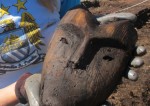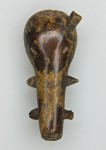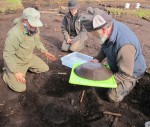 The efforts to excavate the archaeological remains of the Yup’ik Eskimo village of Nunalleq before climate change erodes it into the Bering Sea have been markedly boosted by a £1.1 million in ($1,800,000) research grant from the Arts and Humanities Research Council. University of Aberdeen archaeologists have been digging at the site since 2009 when they were called in by the Yup’ik living in the nearby village of Quinhagak who were alarmed to see their ancestral artifacts being swept out to sea.
The efforts to excavate the archaeological remains of the Yup’ik Eskimo village of Nunalleq before climate change erodes it into the Bering Sea have been markedly boosted by a £1.1 million in ($1,800,000) research grant from the Arts and Humanities Research Council. University of Aberdeen archaeologists have been digging at the site since 2009 when they were called in by the Yup’ik living in the nearby village of Quinhagak who were alarmed to see their ancestral artifacts being swept out to sea.
 Organic elements from human hair to woven grass baskets to wooden planking had been preserved in the permafrost for centuries after the village was abandoned around 1650, but rising global temperatures are melting the permafrost leaving behind brittle soil that is particularly susceptible to erosion. Add the rising sea levels and extreme weather events battering the coast and you have a recipe for destruction. Since that first excavation season, the coastline has lost more than 30 feet.
Organic elements from human hair to woven grass baskets to wooden planking had been preserved in the permafrost for centuries after the village was abandoned around 1650, but rising global temperatures are melting the permafrost leaving behind brittle soil that is particularly susceptible to erosion. Add the rising sea levels and extreme weather events battering the coast and you have a recipe for destruction. Since that first excavation season, the coastline has lost more than 30 feet.
 In order to preserve a uniquely rich archaeological record that project leader Dr. Rick Knecht describes as “one of the clearest records of the past that we know of anywhere in the north,” the University of Aberdeen team in conjunction with the local Yup’ik community have worked assiduously to recover everything they can from the site of the 700-year-old village. So far they’ve already unearthed thousands of artifacts. Highlight artifacts of the 2013 dig include an ivory carving of a mythological monster thought to
In order to preserve a uniquely rich archaeological record that project leader Dr. Rick Knecht describes as “one of the clearest records of the past that we know of anywhere in the north,” the University of Aberdeen team in conjunction with the local Yup’ik community have worked assiduously to recover everything they can from the site of the 700-year-old village. So far they’ve already unearthed thousands of artifacts. Highlight artifacts of the 2013 dig include an ivory carving of a mythological monster thought to
 be a Palraiyuk, a gator-like creature that lived in rivers and lakes emerging to devour humans and animals, and a ceremonial face mask that depicts a person, probably a woman, in the act of transforming into a wolf or fox.
be a Palraiyuk, a gator-like creature that lived in rivers and lakes emerging to devour humans and animals, and a ceremonial face mask that depicts a person, probably a woman, in the act of transforming into a wolf or fox.
The archaeologists excavating Nunalleq don’t just remove artifacts as they come across them; they remove the entire context so they can sift through the soil and organic matter looking for wood chips, plant remains, insects, tiny fish vertebrae,  fur, human bone fragments and hair, all the unglamorous but essential sources of information on how the Yup’ik lived in Nunalleq from the 1300s until the village was raided and abandoned.
fur, human bone fragments and hair, all the unglamorous but essential sources of information on how the Yup’ik lived in Nunalleq from the 1300s until the village was raided and abandoned.
It’s important research because while the Yup’ik are the largest indigenous group in south-western Alaska today, they only came in contact with Europeans in the 1820s and the vast region they inhabit has barely been explored archaeologically.
Dr Knecht added: “This is our first look at pre-contact Yup’ik life. It’s been a complete revelation to both scientists and the local native community.
“The discovery of these artefacts is helping to reintroduce lost skills back into these communities – the skills used to make them may have been lost and are being re-learned. We literally have pieces being recreated within days of being discovered.
“I think the dig is helping to get the local young people interested in their heritage. A group of youngsters recently asked the village elders for permission to form a traditional dance group – something that was supressed by the missionaries more than a century ago. They did their first dance last year and the first song was about the storms washing the site away, and this year they did their first dance in Quinhagak itself – the first in 100 years – and they did it when we showed our summer’s finds to the community.”
 The grant will allow archaeologists to keep digging for the next four years. Part of it will go to archaeological education and training programs, and to fund a regional survey that will identify more sites endangered by the eroding coastline.
The grant will allow archaeologists to keep digging for the next four years. Part of it will go to archaeological education and training programs, and to fund a regional survey that will identify more sites endangered by the eroding coastline.
The artifacts, bulk samples and other materials recovered have all been packed up and sent to Scotland for analysis and conservation. They all remain property of the people of Quinhagak and once the objects have been studied, they will be returned to the area. The plan is to build a local research center and artifact repository where the collection can be maintained in proper conditions. It will also be a pivot for ongoing site protection and rescue operations along the endangered coast.
For more pictures and wonderful write-ups about each day of the dig, do yourself a favor and read the Nunalleq Project blog. These folks work in challenging conditions — here’s Lindsey looking ridiculously cheery despite having to wear an eyepatch because A MOSQUITO BIT HER ON THE EYEBALL — but their commitment, dedication, work ethic and positive attitudes are irrepressible.
This is such a great project for everyone involved- it’s great to see it getting more funding!
I read the head line as Hugh Grant helps save Alaskan melting village . I thought really? excellent, it wasn’t until I reached the end of the article with no mention of his participation that I realized my error. 😆
Good luck to the team, what a pity celebs don’t become involved in things like this it would help funding immensely.
Outstanding! I worked with Dr. Knecht’s amazing son this summer and heard of this wonderful archaeological effort. When RJ spotted “Blue Latitudes” in my nautical history bookshelf, I was reminded that I had read of this excavation previously. DOH! Best wishes and congratulations on the grant!